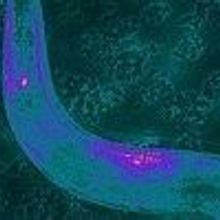chemosensory

How the Gut Differentiates Artificial Sweeteners from Sugars
Chloe Tenn | Jan 21, 2022 | 5 min read
Signals from sweeteners and sugars are relayed from the gut to the brain by different neural pathways, a new study concludes.

Image of the Day: Tuft Cells
Chia-Yi Hou | Apr 3, 2019 | 1 min read
After a severe case of flu, mice have chemosensory cells in their lungs, a place where they don’t normally occur.

Image of the Day: Plastic Feast
The Scientist and The Scientist Staff | Oct 30, 2017 | 1 min read
New research suggests that plastic might just “taste good” to hard corals.

Bitter Taste Receptors in Uterus May One Day Help Prevent Premature Birth
Jef Akst | Oct 1, 2017 | 4 min read
Researchers suggest that the receptors can control early labor contractions.

Fish Smell ATP to Find Food
Sandhya Sekar | Sep 1, 2017 | 2 min read
Sensory neurons in the tip of the zebrafish nose respond to molecular signals released from food sources.

Gut Feeling
Ruth Williams | Jun 22, 2017 | 3 min read
Sensory cells of the mouse intestine let the brain know if certain compounds are present by speaking directly to gut neurons via serotonin.

Fruit Flies Feel Humidity with Dedicated Receptors
Alison F. Takemura | Sep 1, 2016 | 2 min read
Drosophila antennae let the insects seek out moisture levels they like best.

What Sensory Receptors Do Outside of Sense Organs
Sandeep Ravindran | Sep 1, 2016 | 10+ min read
Odor, taste, and light receptors are present in many different parts of the body, and they have surprisingly diverse functions.

A Panoply of Animal Senses
The Scientist | Aug 31, 2016 | 2 min read
Animals have receptors for feeling gravity, fluid flow, heat, and electric and magnetic fields.

Olfactory Fingerprints
Jef Akst | Jun 24, 2015 | 1 min read
People can be identified by the distinctive ways they perceive odors, a new study shows.

Pleasure To Smell You
Jef Akst | Mar 4, 2015 | 2 min read
People tend to sniff their mitts after shaking hands with someone of the same sex, suggesting that the traditional greeting may transmit chemosensory signals.

Vampire Bats Lack Bitter Taste
Jef Akst | Jun 25, 2014 | 2 min read
With a diet of blood, the flying mammals have largely lost the ability to taste bitter flavors.

Making Sense of the Narwhal Tusk
Kerry Grens | Mar 18, 2014 | 2 min read
Emerging evidence suggests that the marine mammal’s long front tooth might help the narwhal sense environmental changes.

Jaws, Reconsidered
Mary Bates | Mar 1, 2014 | 3 min read
Biologist Jelle Atema is putting the sensory capabilities of sharks to the test—and finding that the truth is more fascinating than fiction.

Feeding Frenzy
Mary Bates | Feb 28, 2014 | 1 min read
Take a peek into the shark tank where Boston University biologist Jelle Atema is testing how well the fish actually smell.

Fly Leg Sensors Recognize Mates
Chris Palmer | Jul 1, 2013 | 2 min read
Male fruit flies use a sensory system in their legs to help determine whether a potential mate is from a different species.

Sensing Calories Without Taste
Francie Diep | Apr 22, 2013 | 4 min read
Rodents and fruit flies appear to be able to sense nutrients even when they can’t taste the food they’re eating. Now, researchers are trying to figure out how.

The Sound of Salt
Sabrina Richards | Jan 30, 2013 | 3 min read
A putative ion channel integral to mammalian hearing turns out to be an elusive salt-sensing chemoreceptor in nematode worms.
Sweet and Sour Science
Ruth Williams | Feb 1, 2012 | 3 min read
Japanese researchers unravel the mystery of miracle fruit.
